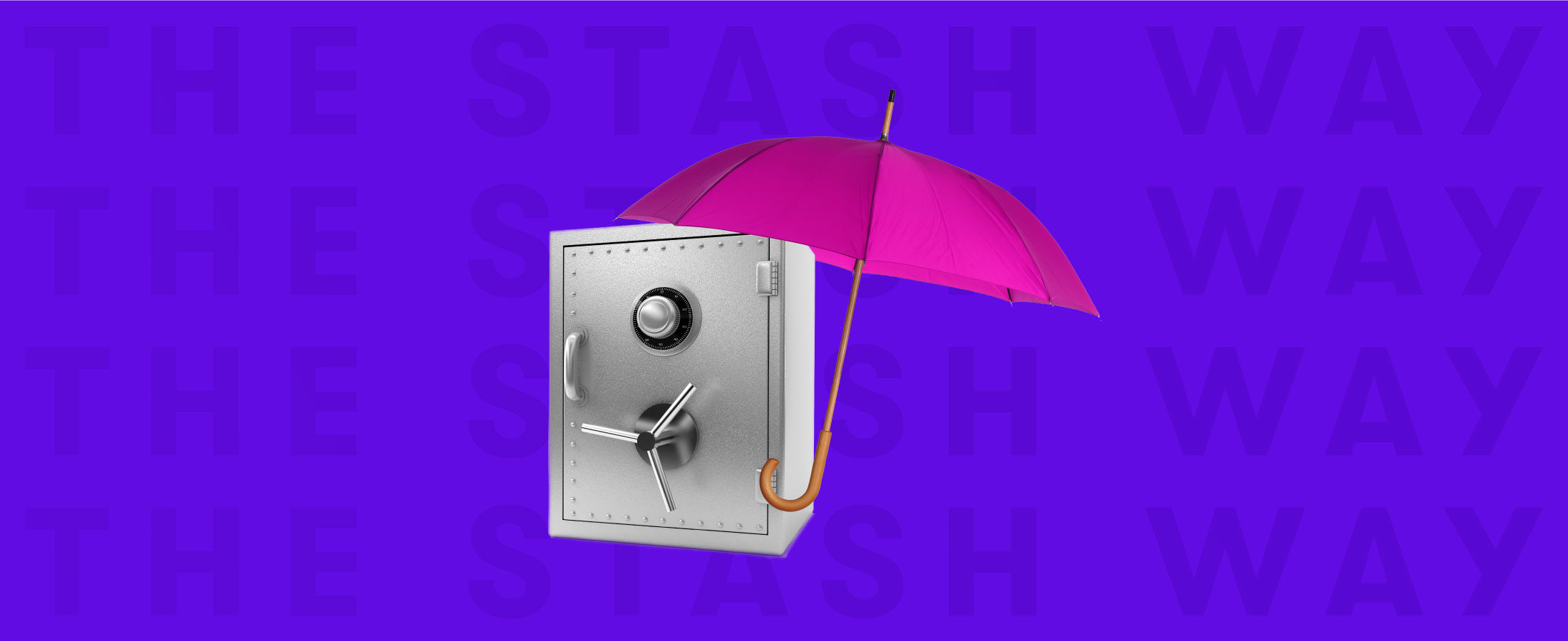Aug 31, 2020
Save For the Unexpected. It’s a Key Part of the Stash Way.
It’s important to have a rainy day fund and emergency fund.

Life often hands us unexpected challenges.
That’s why it’s important to have money set aside, in the event we need to pay for unplanned costs and expenses, whether that’s a broken muffler on the highway, a job layoff, or a sudden illness.
But saving to repair your car and saving for a life-changing event can require different savings strategies, with either a rainy-day fund or an emergency fund.
At Stash we encourage users to create two different kinds of funds. One is called your rainy day fund, and it can be used for short-term unexpected things as they arise. The other is your emergency fund, and it’s for bigger unexpected expenses, such as loss of a job, large medical expenses, or something else of that nature.
Rainy day fund
Your rainy day fund should have between $500 and $1,000 in it, and it should be a liquid account, meaning it should be easily accessible, for example in a bank account. That way, when your dishwasher starts spewing suds on the kitchen floor unexpectedly and you need a few hundred dollars to fix it, it’s there.
Your rainy day fund is liquid (meaning it’s cash). The best place for it is likely in a bank account, such as a savings account, where you can access the money quickly.
Once it’s spent, you can start saving again for the next time because well, life happens.
Emergency fund
An emergency fund, on the other hand, is for when life throws you a major curveball, so you have money to fall back on. Your emergency fund should have enough money to cover your expenses for three to six months. You’ll use this money in the event of a more serious setback, such as a layoff or an illness that prevents you from working.
How much should be in this fund? That all depends on you, your fixed expenses, and what you’ll need to keep yourself going in a really tough time. Is your monthly spending $2,000 or maybe $4,000? Whatever the amount for your monthly expenses is, multiply it by three or by six. That’s how much you should try to put away.
Since this fund is for longer-term planning, you may want to keep it in a place where it can earn some interest. That’s because your money could sit in this account for years, and the typical bank account pays very low interest, which may wear away at your savings due to inflation.
You can keep it in a money market fund or maybe in a certificate of deposit (CD). You may also consider putting the money in an exchange-traded fund (ETF ) based on short-term U.S. Treasuries.
Important note: Any time you invest in a security such as a stock, bond, or ETF, it involves risk. You can lose money on your investments. The same may not be true for a standard bank account or CD.
Here’s one very important thing to keep in mind: Since you may be keeping your backup fund money in an investment vs. a savings account, it may take you a few days to access it.
Life is just generally much more stressful when you know you’re one emergency away from financial ruin. By saving up an emergency fund, you’ll sleep more easily knowing that you can handle the unexpected costs life will inevitably throw at you.
Start saving small amounts, and then try increasing those amounts over time. It may take a while, but pretty soon you can have both your rainy day and emergency funds flush with cash.
Once both accounts are fully funded, you may have the financial freedom to pursue other goals, like investing, saving for retirement, your child’s education, a house, and more. And more importantly, you’ll know that if things go wrong, you’re covered.
Remember, your paycheck has a lot of demands placed on it. There are always bills to pay, temptations to buy. So think about assigning every dollar you earn a purpose, which can help you stay in the lanes you’ve set for yourself on your financial journey.
Consider Auto-Stash
Stash’s financial tool Auto-Stash is a powerful suite of tools that can help you put your saving strategy on automatic. That way you won’t even have to think about it. In fact, during 2019 Stash customers who used Auto-Stash saved twice as much as customers who did not turn auto-Stash on1, and you can use Stash’s partitions² to set up both an emergency and a rainy day fund.
Using automated saving strategies removes the decision making needed every time you see your paycheck. You’ll be able to plan for anticipated expenses and save for the unexpected expenses.
1Methodology: This analysis was done by comparing Stash users who had Auto-Stash on for at least a year (86,718 users) vs. users who had never turned on the Auto-Stash feature (24,101 users) but continued to save without Auto-Stash throughout that year. The amount saved is the average dollar amount users were able to save in their Stash accounts in a one year time period starting on the date of their first transfer or first Auto-Stash.
2Money moved into a partition must be moved back to the bank account available balance to be used and does not earn interest.
Related Articles

Stock Market Holidays 2024

The 2024 Financial Checklist: A Guide to a Confident New Year

9 Ways to Celebrate Financial Wellness Month

Budgeting for Young Adults: 19 Money Saving Tips for 2024

The Best Personal Finance Books on Money Skills, Investing, and Creating Your Best Life for 2024

What Is a Financial Plan? A Beginner’s Guide to Financial Planning





